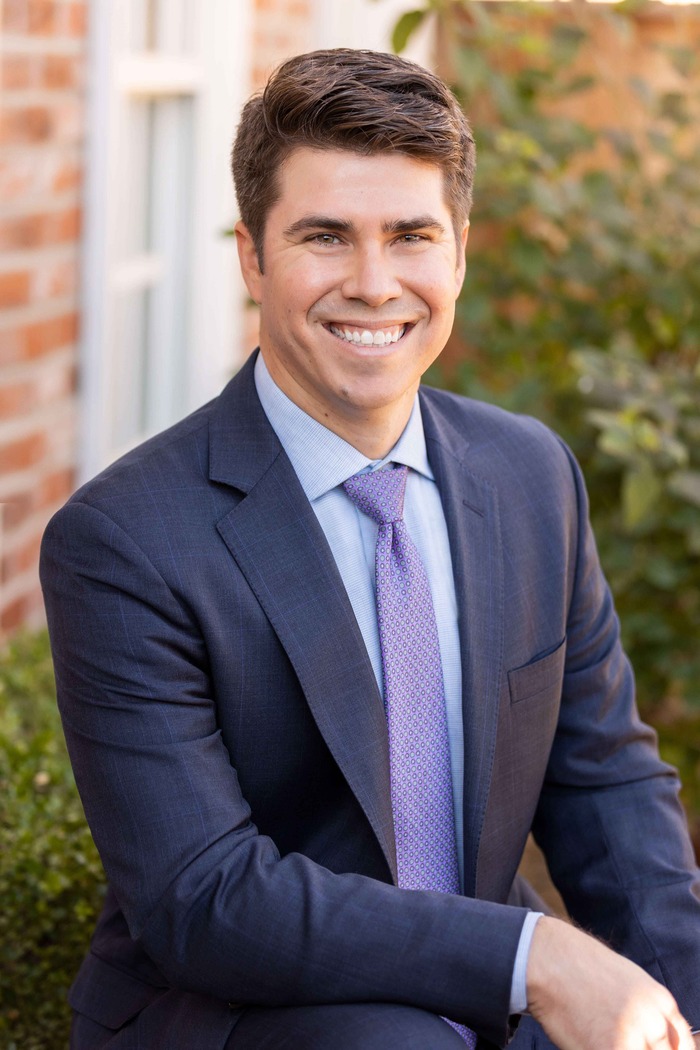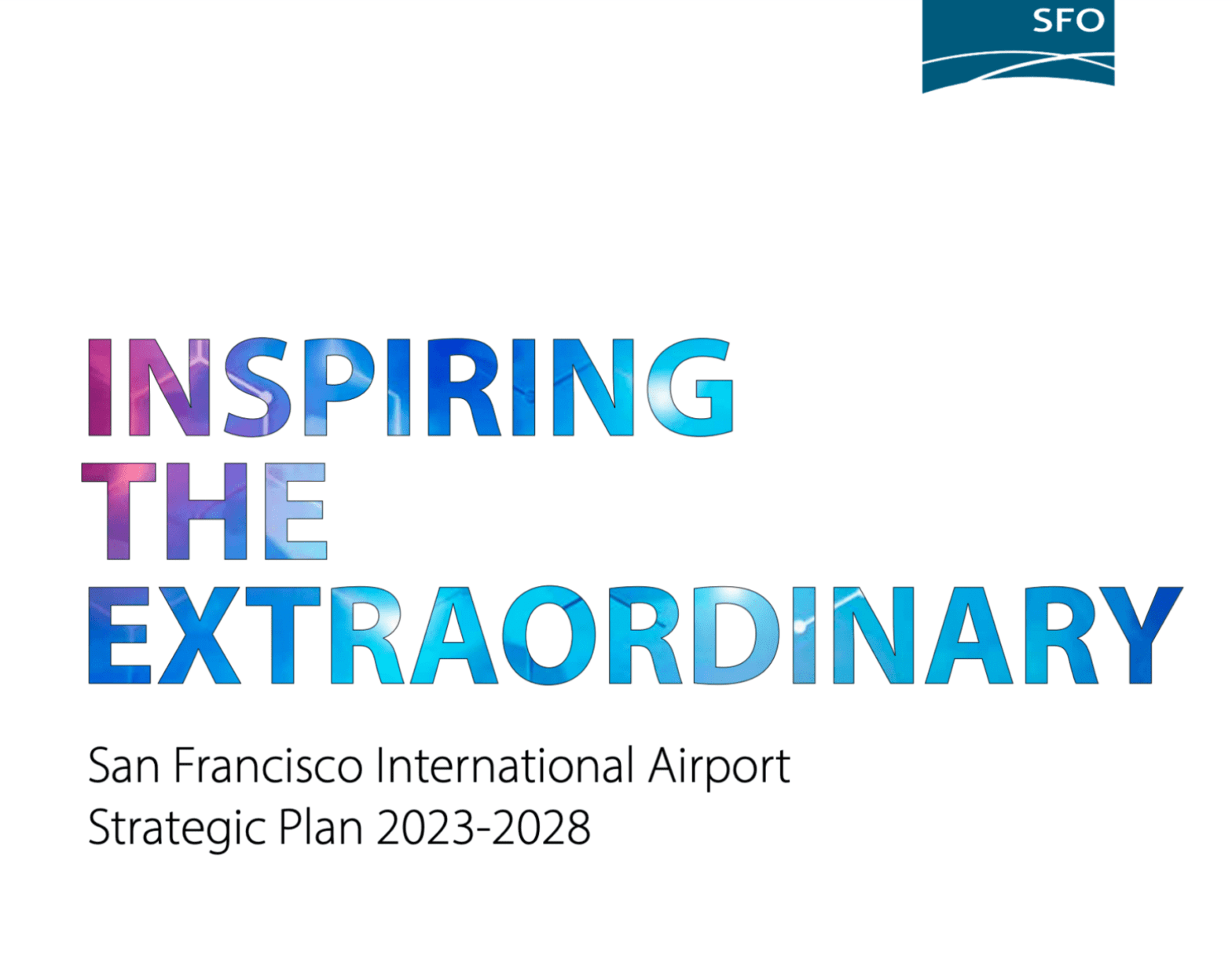
As I reflect on 2023 and transition into the new year, I wanted to share the story of working on SFO’s Five-Year Strategic Plan. Professionally, this was one of the most exciting and rewarding projects I have ever worked on. The experience was a valuable departure from my typical practice of supporting construction project delivery and at the end I’ll be sharing valuable lessons learned you can apply to your strategic planning efforts.
 The process concluded on November 7, 2023, when the San Francisco Airport Commission unanimously approved the new Five-Year Strategic Plan. Airport Director, Ivar Satero, shared the journey with the Commissioners, who expressed enthusiasm about our approach, which emphasized culture, inclusion, creativity, and striving for excellence. It was truly my honor to support SFO’s Leadership Team with this document, which was created by including more than 350 people from all levels of the airport in the process. Our goal was to create a robust Strategic Plan that would serve as a roadmap for the airport and its employees who serve upwards of 50 million passengers per year. The development process involved continually emphasizing our Partnering values of collaboration, alignment, and tapping into the collective wisdom of the organization.
The process concluded on November 7, 2023, when the San Francisco Airport Commission unanimously approved the new Five-Year Strategic Plan. Airport Director, Ivar Satero, shared the journey with the Commissioners, who expressed enthusiasm about our approach, which emphasized culture, inclusion, creativity, and striving for excellence. It was truly my honor to support SFO’s Leadership Team with this document, which was created by including more than 350 people from all levels of the airport in the process. Our goal was to create a robust Strategic Plan that would serve as a roadmap for the airport and its employees who serve upwards of 50 million passengers per year. The development process involved continually emphasizing our Partnering values of collaboration, alignment, and tapping into the collective wisdom of the organization.
“As we embarked on developing the new Five-Year Strategic Plan, I felt it was essential to have someone guide us who already understood SFO’s culture, complexity, and commitment to collaboration. Originally, we considered including Rob Reaugh of OrgMetrics LLC as a trusted advisor to support our process. In the end, our team recommended he help guide the development of the entire plan. The result was an exemplary collaboration between Rob, Corina Monzón (SFO’s Managing Director, Strategy & Social Impact), and our Senior Staff, who delivered the most inclusive and engaging strategic planning process we have performed to date.”- Ivar C. Satero, Airport Director
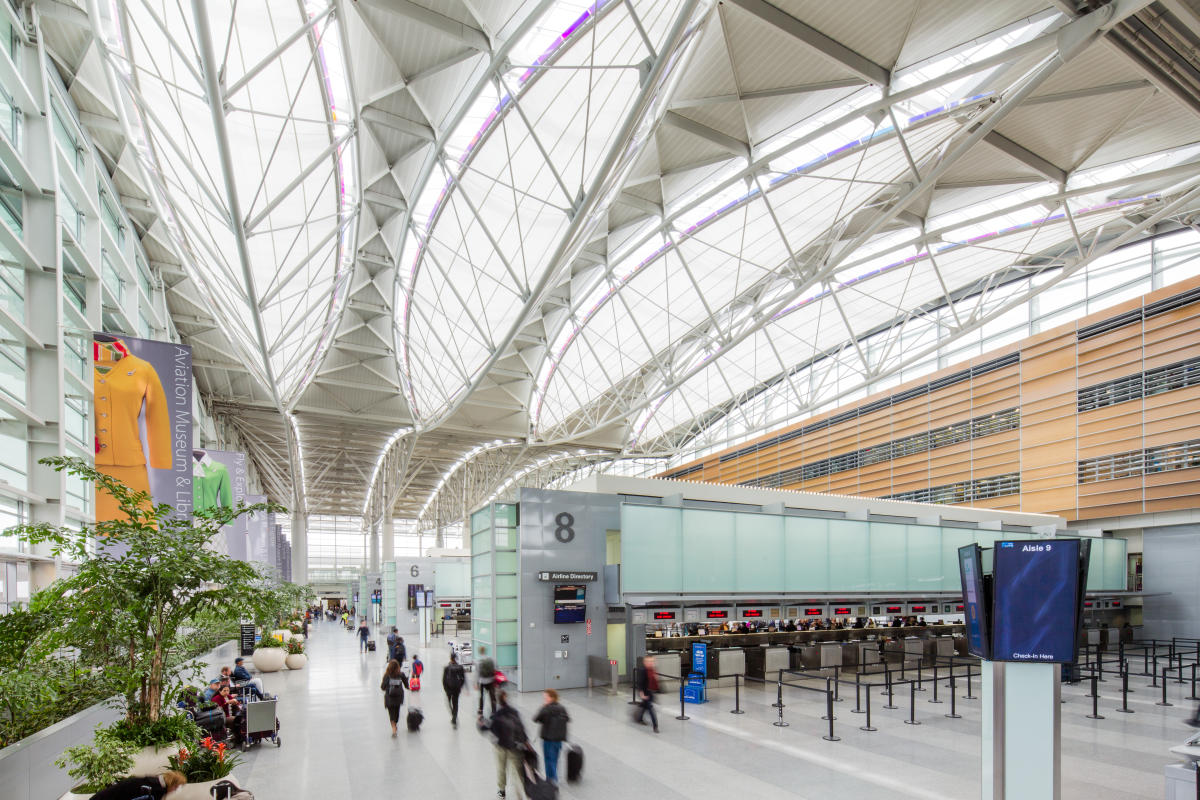 The result of the effort was the creation of new vision and mission statements and six new strategic goals. I will share how we developed each of these elements along the way.
The result of the effort was the creation of new vision and mission statements and six new strategic goals. I will share how we developed each of these elements along the way.
Mission: Delivering an airport experience where people and our planet come first.
Vision: Inspiring the Extraordinary
- Empower a Culture of Safety and Security Excellence
- Provide an Outstanding Guest Experience
- Elevate SFO Pride through an Exceptional Employee Experience
- Take Bold Climate Action
- Ignite Business Innovation
- Achieve Social Impact through Partnerships
How We Got There
As Corina, myself, and the team thought about crafting the Strategic Plan, we felt it was important to reflect on what we do really well with our construction projects to ensure exceptional results. We start with a blank piece of paper, a smart and diverse team, and get to work. Coming out of COVID, the SFO Senior Leadership team had added several new leaders, so our first objective was to invest the time to build relationships and cohesion that would inevitably improve our outcomes as a team. We did a personality assessment to instill empathy and promote understanding, conducted a traditional SWOT analysis, and then organized Senior Leadership retreats to develop our Strategic Goals and define our new Mission and Vision.
We began the process by concentrating on the Goals, using the SWOT analysis as our contextual foundation to identify SFO’s sustainable competitive advantage. I challenged the Senior Leadership team to create four or possibly five goals for priority and focus. This was a difficult task, and our final product includes six well-thought-out goals that we believe are inspiring, durable, and most importantly, can be implemented.
At the initial retreat, Director Satero challenged the Senior Leadership team to “be bold” with our plan and encouraged a psychologically safe environment where everyone could share their ideas openly and without judgment.
Perhaps not surprisingly, due to SFO’s history of environmental leadership among airports our first durable goal (which survived from the initial retreat) was “Take Bold Climate Action.” As we prioritized the goals, we also focused on the Guest Experience (which helped SFO achieve the Number 1 rating for airports of its size in the Wall Street Journal), the Employee Experience (to help ensure we recruit and retain top talent moving forward), Ignite Business Innovation (to help drive non-aviation revenue and small/local business participation), and Achieve Social Impact through Partnerships (to foster SFO’s leadership as a cultural hub, provide educational opportunities and workforce pipeline and development programs). The final goal, which became Goal 1, Empower a Culture of Safety and Security Excellence, was developed after reviewing the initial draft plan. The review revealed that Safety and Security were integral to each of the goals, and as an SFO core value, it deserved to be elevated to its own strategic goal.
 At the leadership offsite retreat, we conducted several exercises as we drafted the initial goals, but perhaps the most meaningful activity was for the Mission Statement development. The Senior Leadership team formed smaller groups where they shared stories about their most impactful accomplishments during their time at SFO. The discussions were frank and open, serving as a platform for deepening our conversations and strengthening the cohesion of the leadership team. Upon reflection at the end of the day we all recognized that each story shared involved collaborative efforts across divisions to successfully deliver projects, programs, or initiatives. We do our best work as a team!
At the leadership offsite retreat, we conducted several exercises as we drafted the initial goals, but perhaps the most meaningful activity was for the Mission Statement development. The Senior Leadership team formed smaller groups where they shared stories about their most impactful accomplishments during their time at SFO. The discussions were frank and open, serving as a platform for deepening our conversations and strengthening the cohesion of the leadership team. Upon reflection at the end of the day we all recognized that each story shared involved collaborative efforts across divisions to successfully deliver projects, programs, or initiatives. We do our best work as a team!
As we built the Mission Statement and sought broader staff input we coalesced on the key terms “Airport,” “People,” and “Planet,” resulting in “Delivering an airport experience (honoring SFO operations and security), where our people (our staff, tenants, and guests), and our planet (stewardship to slow climate change) come first.
Finalizing the Mission Statement was a thoughtful consensus-based process where the Senior Leadership team carefully deliberated on the significance of every word, considering how it resonated with staff at all levels. This effort reminded me of British author William Hazlitt’s quote, “Simplicity of character is the natural result of profound thought.”
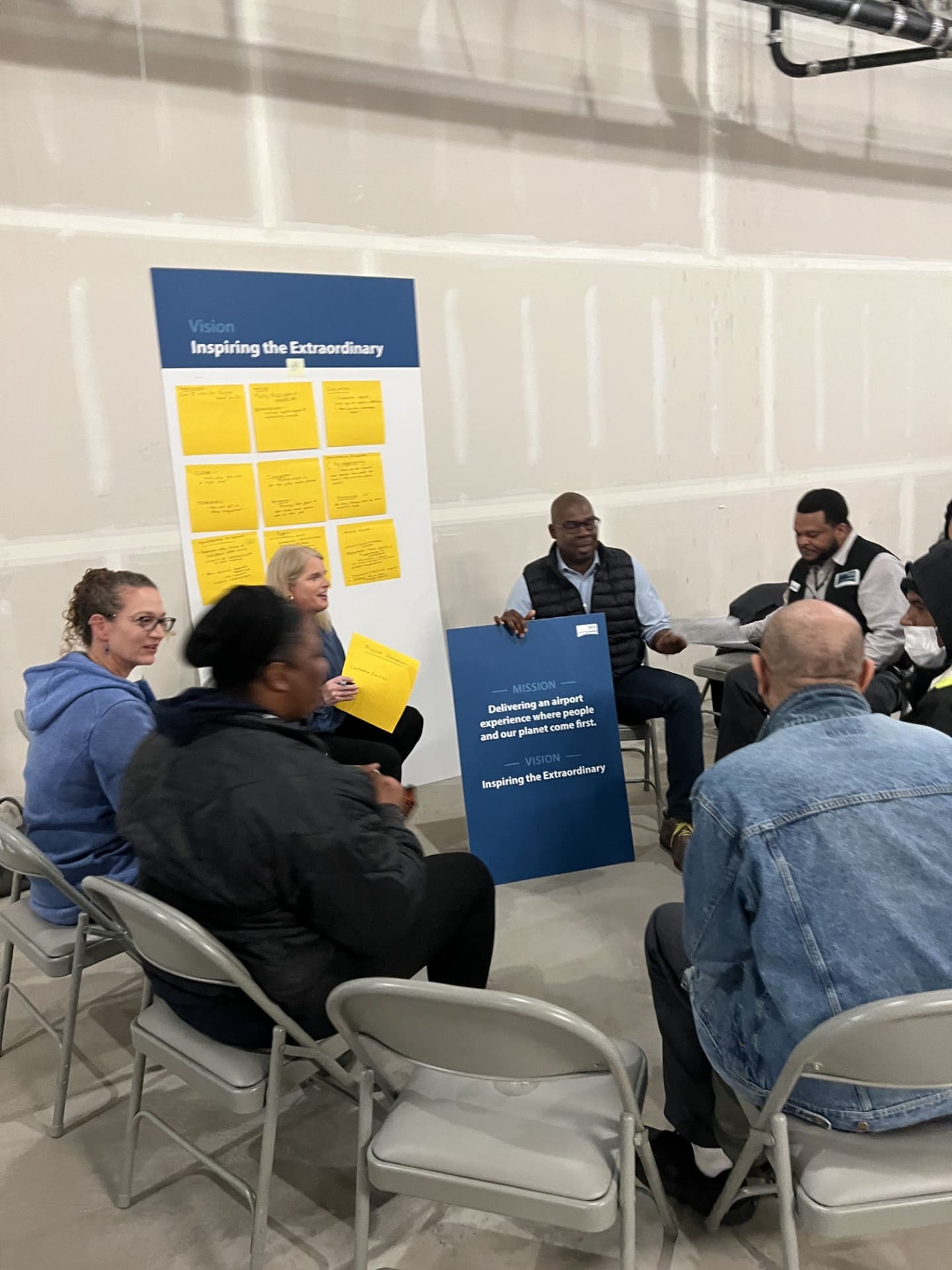 For the new Vision Statement, the Senior Leadership team landed on concept of Extraordinary as the north star for our new plan. The previous vision was “Reaching for Number 1,” which effectively guided SFO for 12 years and multiple strategic plans. For this plan, the leadership team wanted to set its ambitions on reaching bold new heights rather than compare SFO to others as the metric of success and guide to the future. To land on the final vision and mission statements, we took our draft statements and goals to two staff focus groups, amended them based on the feedback, and then shared the vision and mission broadly in the form of two multilingual town halls, conducted in collaboration with two dynamic consulting firms InterEthnica and Civic Edge Consulting (see graphic of the process below).
For the new Vision Statement, the Senior Leadership team landed on concept of Extraordinary as the north star for our new plan. The previous vision was “Reaching for Number 1,” which effectively guided SFO for 12 years and multiple strategic plans. For this plan, the leadership team wanted to set its ambitions on reaching bold new heights rather than compare SFO to others as the metric of success and guide to the future. To land on the final vision and mission statements, we took our draft statements and goals to two staff focus groups, amended them based on the feedback, and then shared the vision and mission broadly in the form of two multilingual town halls, conducted in collaboration with two dynamic consulting firms InterEthnica and Civic Edge Consulting (see graphic of the process below).
The town halls were incredible! With 339 staff participating in two sessions on May 4, 2023 at 9:00 am and 8:00 pm to accommodate all shifts. These were not a show and tell sessions, instead we had small in-language break out groups with facilitators in English, Spanish, Cantonese and Filipino. The format empowered staff to share their own stories of when SFO was Extraordinary, and more importantly, where we had opportunities to grow in order to live up to the vision. By selecting trusted facilitators and translators, we heard amazing stories of customer service, meaningful relationships, and perhaps more importantly, received candid feedback about facilities, customer service, concessions, and more and have since implemented changes from these valuable insights.
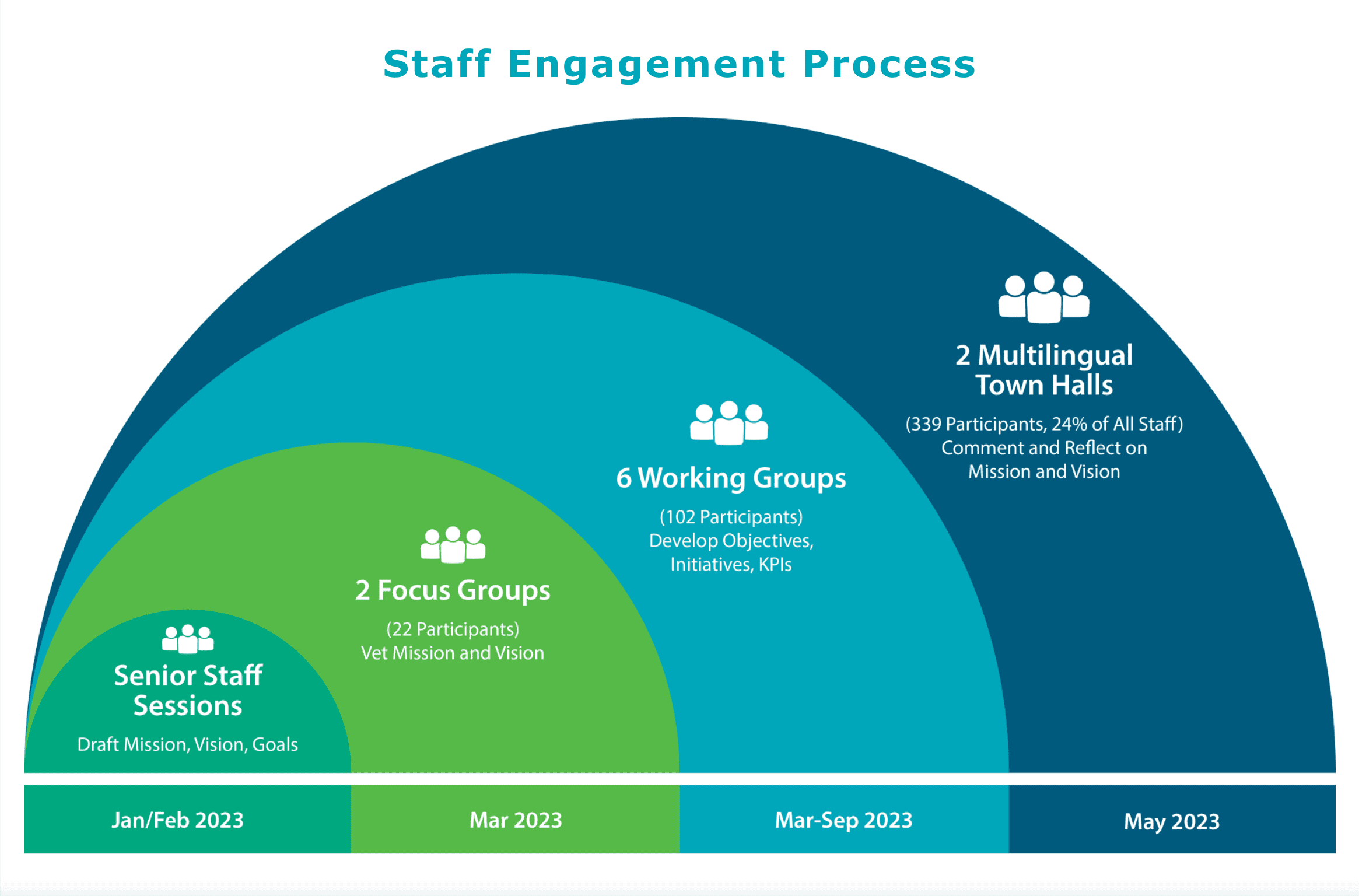 In parallel to planning and executing the town halls we formed goal working groups led by Senior Leadership co-champions. The working groups were tasked developing objective statements (3-6 per goal) and specific initiatives. There were over 100 staff members who participated in a series of four facilitated workshops to more fully define the goals.
In parallel to planning and executing the town halls we formed goal working groups led by Senior Leadership co-champions. The working groups were tasked developing objective statements (3-6 per goal) and specific initiatives. There were over 100 staff members who participated in a series of four facilitated workshops to more fully define the goals.
There were a few key lessons that we applied to this Strategic Plan that I would highly recommend other organizations consider.
- Honor People’s Time and Interests: We had six strategic goals and wanted to assemble diverse participation from across the entire organization. We did not want this to be a top-down Strategic Plan. We wanted this to involve leaders from Airfield Safety Officers, Concessions, Security, Tenant Relations, Design and Construction, Information Technology, and Planning and Sustainability. We wanted insight from our accountants, custodians, HR professionals, skilled trades, trainers… everyone. We also wanted to acknowledge that many individuals were already working incredibly hard through the COVID recovery, so we did a voluntary sign-up for people to participate in the Strategic Plan development, allowing them to prioritize participation in goals based on their personal and professional interests, and then allowed them to opt-out. This choice helped with commitment and buy-in to the fairly rigorous development process.
- Maintain Momentum: For each of the goal workshops, we developed a structured approach that included a report from the previous meeting containing photos of the easels each subgroup worked on to help them remember what they had worked on last time. It was critical to remember we were pulling people out of their day job to come to work on the Strategic Plan. We had them focus on strategy, brainstorming, and developing draft objectives and initiatives.
- Educate and Level-Set: In each workshop, we gave briefings on the global strategic planning process, informed them of what the other groups were working on, had them focus on developing SMART Objective and Initiative Statements, and also did break-outs focused on key technical elements of a topic when it was warranted. A five-minute briefing at the top helped prevent repetitive process-focused questions that would have bogged down each workshop.
- Dashboard for Implementation: As a final exercise, we prepared a dashboard/placemat for the Senior Leadership team to review the entire Strategic Plan (mission, vision, goals, objectives, and initiatives), which allowed them to a) ensure we did not have overlaps, b) help identify who would be the lead division and who might be the secondary to drive each initiative, and c) assess if any of the initiatives would require new hires and/or resources to implement. By adding this final step, we were able to consolidate several initiatives, and have already made this Strategic Plan much more practical to implement as the Senior Leadership team prepares for the upcoming budget cycle.
- Make it Fun: I want to stress was how this was an incredible amount of very detailed work, and it required a very high level of structure and organization to implement, but over and over again, we received feedback from the working groups and the town hall participants that this felt “important,” “engaging,” and “fun.” Perhaps most importantly, by applying our Partnering principles to the planning process, we got an inspired document that we believe will remain meaningful and durable because it came from the collective wisdom from all levels of SFO’s staff.
As one of our volunteers for the town hall who has worked on multiple Progressive Design-Build Projects described it, “this was the most SFO-like strategic plan ever conceived.” I am so proud of the work we did to tap into the collective wisdom of SFO’s staff to create this plan. I am even more grateful for the opportunity to serve the Airport with a Strategic Plan that not only serves as a platform for the next five years but also inspires extraordinary achievements in the journey ahead.
– Rob
Rob Reaugh is President of OrgMetrics LLC. He facilitates the City and County of San Francisco Collaborative Partnering Steering Committee and currently works with San Francisco International Airport, San Jose International Airport, BART, Caltrans, and others. He holds a Masters’ Degree in Alternative Dispute Resolution.For more information please contact Rob Reaugh, RobReaugh@Orgmet.com / (925) 487-2404 (cell), or OrgMetrics, (925) 449-8300.


